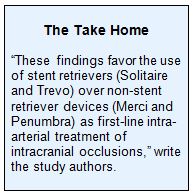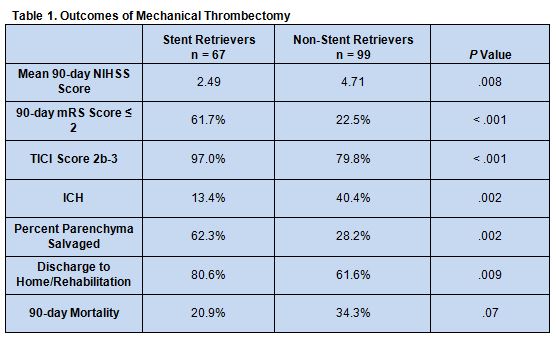Key Points:
- Study compares outcomes of mechanical thrombectomy with stent retrievers vs non-stent retrievers
- Outcomes superior with stent retrievers
Mechanical thrombectomy provides better outcomes for patients with acute ischemic stroke when it is performed using stent retrievers instead of other devices, a single-center, retrospective study suggests. The findings were published online April 29, 2016, ahead of print in the Journal of Neurosurgery.
Stavropoula Tjoumakaris, MD, of Thomas Jefferson University Hospital (Philadelphia, PA), and colleagues examined data on 166 patients who were treated for acute ischemic stroke at Jefferson Hospital for Neuroscience between January 2008 and June 2014. Of those, 67 were treated with stent retrievers, either Solitaire or Trevo, and 99 were treated with other devices, either Merci or Penumbra.
Use of stent retrievers was associated with lower 90-day National Institutes of Health Stroke Scale (NIHSS) scores, and a higher likelihood of having a good outcome at 90 days (defined as a modified Rankin Scale [mRS score] ≤ 2) and complete recanalization (defined as a TICI score 2b-3). There was also a greater percentage of parenchyma salvaged, a higher rate of discharge to home/rehabilitation, and a lower rate of symptomatic intracranial hemorrhage (ICH) in the stent retriever group. Finally, use of stent retrievers was associated with a trend toward lower 90-day mortality (table 1).
Use of non–stent retriever devices was an independent predictor of mRS Scores 3-6 (P = 0.002), whereas use of stent retrievers was the only independent predictor of TICI score 3 (P < 0.001).
“These findings favor the use of stent retrievers (Solitaire and Trevo) over non-stent retriever devices (Merci and Penumbra) as first-line intra-arterial treatment of intracranial occlusions,” write the authors. “Additional multi-institutional studies should be done to confirm our findings.”
Source:
- Hentschel KA, Daou B, Chalouhi N, et al. Comparison of non-stent retriever and stent retriever mechanical thrombectomy devices for the endovascular treatment of acute ischemic stroke. J Neurosurg. 2016;Epub ahead of print.
Disclosures:
- Dr. Tjoumakaris reports being a consultant for Stryker and Covidien.



